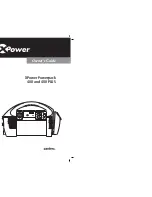
MAINTENANCE
Replacing carbon motor
brushes
The carbon motor brushes will wear down and
require replacing. The time intervals between
replacements will vary depending upon the
working environment and the hours of use. It
is recommended that the brushes be checked
after each 10 hours of use. When the length of
the carbon brush reaches 1/4" (6.35 mm), the
brushes should be replaced.
WARNING:
Unplug the tool
from the power source.
1.
Use a 3/16" (5 mm) slot screwdriver and
remove one brush cap (1) (fig. 8). Turn the
brush cap counter clockwise to remove it
from the motor housing.
2.
Pull the spring & brush assembly (2) from
the brush holder (3) in the motor housing
(4).
3.
Insert the new spring & brush assembly into
the motor housing.
4.
Compress the spring into the brush holder
and thread the brush cap back into the
motor housing.
NOTE:
Make sure the brush cap threads are
not cross-threaded. Do NOT over tighten.
5.
Repeat steps 1 to 4 to replace the second
carbon brush located on the opposite side of
the motor housing.
24
WARNING:
When servicing,
use only identical replacement parts. Use of any
other part may create a hazard or cause product
damage.
DO NOT abuse power tools. Abusive practices can
damage the tool as well as the workpiece.
WARNING:
DO NOT attempt
to modify tools or create accessories. Any such
alteration or modification is misuse and could
result in a hazardous condition leading to possible
serious injury. It will also void the warranty.
Cleaning
DO NOT use solvents when cleaning plastic parts.
Most plastics are susceptible to damage from
various types of commercial solvents and may be
damaged by their use. Use a clean cloth to remove
dirt, dust, oil, grease, etc.
WARNING:
Do not at any time
allow brake fluids, gasoline, petroleum-based
products, penetrating oils, etc. to come in contact
with plastic parts. They contain chemicals that can
damage, weaken or destroy plastic.
It has been found that electric tools are subjected
to accelerated wear and possible premature
failure when they are used on fiberglass boats
and sports cars, wallboard, spackling compounds
or plaster. The chips and grindings from these
materials are highly abrasive to electric tool
parts such as bearings, brushes, switches, etc.
Consequently, it is not recommended that this tool
be used for extended work on any fiberglass
material, wallboard, spackling compounds or
plaster. During any use on these materials it is
extremely important that the tool be cleaned
frequently by blowing out with an air jet.
25
!
MAINTENANCE
fig. 8
WARNING:
Always wear
safety goggles or safety glasses with side shields
during all operations. It is critical that you also
wear safety goggles or safety glasses with side
shields and a dust mask while blowing dust out of
the rotary tool with an air jet. Failure to take these
safety precautions could result in permanent eye
or lung damage.
Lubrication
All of the bearings in this rotary tool are lubricated
with a sufficient amount of high-grade lubricant
for the life of the unit under normal conditions.
Therefore, no further lubrication is required.
!
!
!
!
DELUXE CORDED ROTARY TOOL KIT 054-4892-4
DELUXE CORDED ROTARY TOOL KIT 054-4892-4

































